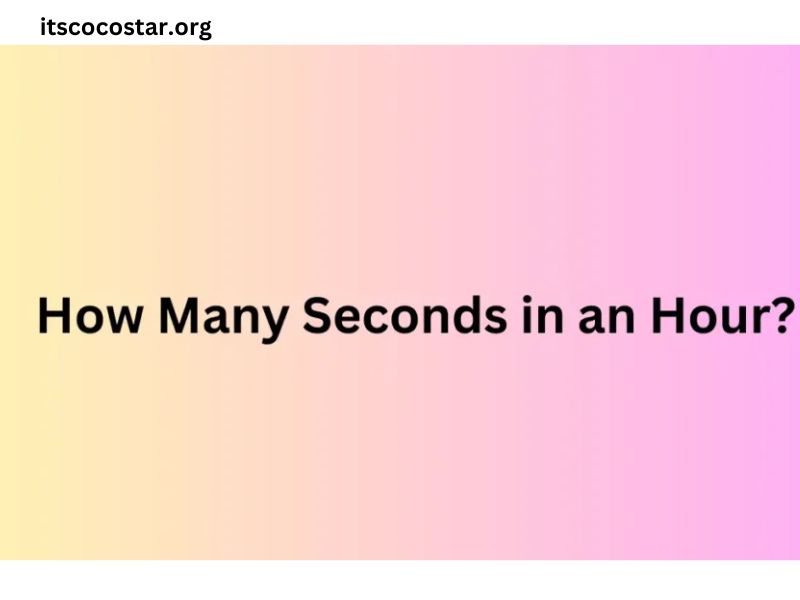Time is an essential aspect of our lives, influencing everything from daily routines to long-term planning. Among the various units of time, the hour is one of the most commonly used, particularly in contexts such as work, education, and daily schedules. But have you ever stopped to consider how many seconds are in an hour? The answer is straightforward, yet the implications of this measurement can be profound.
The Basics of Time Measurement
Before we delve into the specifics of seconds and hours, it’s helpful to understand how time is measured. The concept of time is rooted in natural phenomena—primarily the rotation of the Earth. One complete rotation of the Earth on its axis defines a day, and the division of that day into smaller units led to the development of hours, minutes, and seconds.
The Hour
An hour is traditionally defined as one-sixtieth of a day, which is further divided into minutes and seconds. An hour is commonly recognized as consisting of 60 minutes, and each minute consists of 60 seconds.
Calculating Seconds in an Hour
To find out how many seconds are in an hour, we can use simple multiplication:
Seconds in an hour=Minutes in an hour×Seconds in a minute\text{Seconds in an hour} = \text{Minutes in an hour} \times \text{Seconds in a minute}
Given that there are 60 minutes in an hour and 60 seconds in a minute, the calculation is as follows:
Seconds in an hour=60 minutes×60 seconds=3600 seconds\text{Seconds in an hour} = 60 \text{ minutes} \times 60 \text{ seconds} = 3600 \text{ seconds}
Thus, there are 3600 seconds in an hour.
The Historical Context of Time Measurement
The division of time into hours, minutes, and seconds has a long history. The ancient Egyptians were among the first to divide the day into 24 hours. This system was later adopted by the Greeks and the Romans, eventually becoming the standard in many cultures around the world.
Why 60?
The choice of 60 as a base for minutes and seconds stems from the ancient Sumerians, who used a base-60 numeral system. This choice was likely influenced by the number’s factors; 60 can be divided evenly by 1, 2, 3, 4, 5, 6, 10, 12, 15, 20, 30, making it versatile for calculations and divisions.
The Significance of Time Measurement
Understanding how many seconds are in an hour is not just a matter of mathematical calculation. It has practical implications across various fields, from science to daily life.
In Everyday Life
In our daily routines, time management is crucial. Knowing how many seconds are in an hour allows us to better allocate our time for tasks. For instance, if you have a project that requires 1.5 hours, you can quickly convert that to seconds:
1.5 hours=1.5×3600 seconds=5400 seconds1.5 \text{ hours} = 1.5 \times 3600 \text{ seconds} = 5400 \text{ seconds}
This conversion aids in planning and efficiency.
In Science and Technology
In scientific experiments, precise measurements of time can be critical. For instance, in physics, the speed of light is often measured in meters per second. Having an accurate understanding of time allows scientists to make precise calculations and predictions.
In Health and Fitness
In the realm of health and fitness, timing can play a significant role. Whether it’s measuring heart rates during exercise, tracking the duration of workouts, or timing intervals for training, the ability to calculate time in seconds can enhance performance and results.
Cultural and Philosophical Perspectives on Time
Beyond its practical applications, the concept of time holds various meanings in different cultures and philosophical perspectives. Time can be seen as linear or cyclical, and its measurement can reflect societal values and beliefs.
Time as a Linear Progression
In many Western cultures, time is viewed as linear, flowing from past to present to future. This perspective emphasizes schedules and deadlines, making the precise measurement of time essential in professional and personal contexts.
Time as a Cyclical Concept
In contrast, some Eastern philosophies and indigenous cultures view time as cyclical, focusing on natural rhythms and seasonal changes. In such contexts, the measurement of time may be less rigid, allowing for a more fluid approach to daily life.
The Role of Technology in Time Measurement
With the advent of technology, our methods for measuring and understanding time have evolved significantly. From sundials and hourglasses to atomic clocks and digital devices, the tools we use have become increasingly precise.
Atomic Clocks
Atomic clocks are among the most accurate timekeeping devices available today. They measure time based on the vibrations of atoms, allowing for an accuracy of up to one second over millions of years. This precision has significant implications for global positioning systems (GPS), telecommunications, and scientific research.
Digital Devices
Today, most people carry smartphones or smartwatches that constantly keep track of time. These devices have integrated various functionalities, allowing users to set timers, alarms, and reminders—all based on the seconds and minutes within an hour.
The Future of Time Measurement
As we look to the future, questions about how we measure and perceive time continue to evolve. With advancements in technology, we may find ourselves reevaluating traditional concepts of time and its measurement.
The Impact of Technology on Perception of Time
The fast-paced nature of modern life, driven by technology, has altered how we perceive time. With the ability to communicate instantly and access information at our fingertips, many people feel that time moves faster than ever. This perception can lead to stress and a constant rush, highlighting the importance of time management.
Potential Changes in Time Measurement
There are ongoing discussions about the potential need to redefine time measurement. As we learn more about the universe and the nature of time itself, we may find new ways to understand and quantify time that challenge our current systems.
Conclusion
In conclusion, while the calculation of how many seconds are in an hour is straightforward—3600 seconds—it opens up a rich discussion about the nature of time itself. From historical perspectives to technological advancements, the significance of time measurement permeates every aspect of our lives. Understanding this fundamental concept not only helps us in practical matters but also encourages a deeper reflection on how we relate to time in a rapidly changing world. Whether in the workplace, during exercise, or in our personal lives, being aware of time—and its precise divisions—enables us to live more consciously and effectively.







